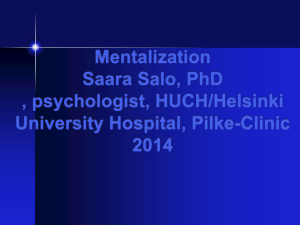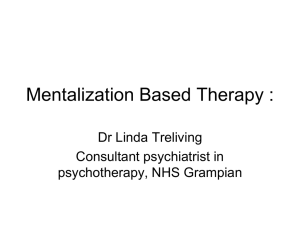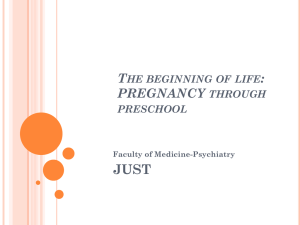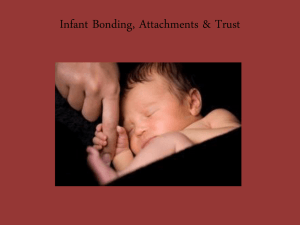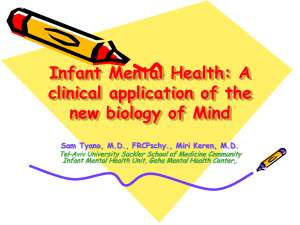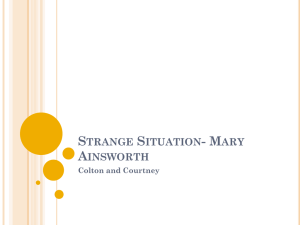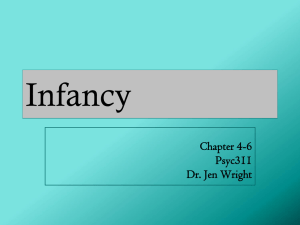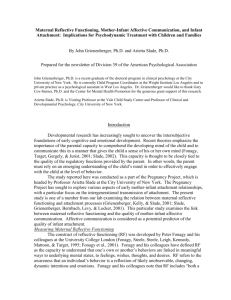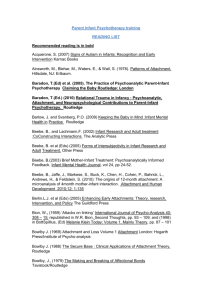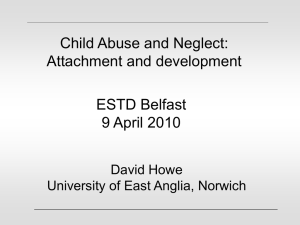March 10, 2011 - Myweb @ CW Post
advertisement
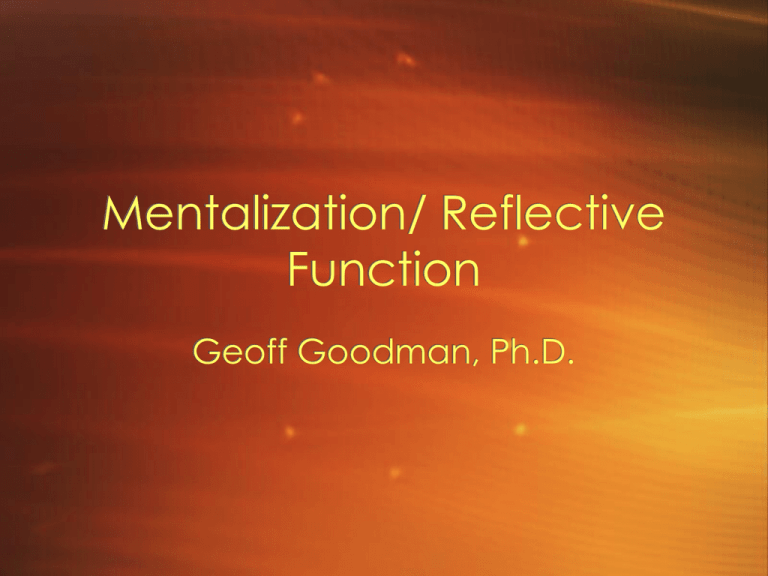
Mentalization/ Reflective Function Geoff Goodman, Ph.D. I. Origin of Concept of Self A. William James’ idea of two selves 1. self as subject (“I”)-- agent 2. self as object (“me”)-- mental representation of “I” B. Theory of mind 1. capacity to respond to others’ behaviors 2. capacity to respond to others’ beliefs, attitudes, desires, hopes, knowledge, imagination, pretense, deceit, intentions, plans 3. capacity to “read” other people’s minds 4. reflective function (RF)-operationalization of the psychological process underlying the capacity to mentalize (Fonagy et al., 2002, p. 24) 5. important determinant of individual difference in self-organization II. Concept of Reflective Function A. What it is not 1. introspection- consciousness or self-report (conscious self-knowledge) 2. insight- knowledge gained about oneself B. Definition 1. unconscious, automatic, implicit, nondeclarative procedure 2. used to regulate emotions and behaviors 3. understanding of reciprocal influences between feelings and behaviors of self in relation to others Continued… C. Conceptually similar concepts 1. depressive position (Klein)-recognition of others’ suffering 2. empathy (Kohut)-- feeling what another person is feeling 3. alpha function (Bion)-metabolization of unthinkable experiences III. Development of Mentalization A. Theory-- theory approach 1. theory-- like network of interdependent propositions about the mind 2. based on interpersonal experiences B. Simulation approach 1. imaging how we would act in interpersonal situations (introspection) 2. imagining being the other person in the interaction Continued… C. Fonagy’s approach 1. understanding of mental states embedded within social world of the family 2. intensely emotionally charged relationships 3. social world “gives” intentionality to child IV. Attachment and Reflective Function (RF) A. Understanding process of RF transmission through intergenerational attachment studies 1. parents have IWMs of their relationships with early caregivers 2. IWMs affect the development of mental representation of child 3. parenting behaviors in emotionally charged situations affect child 4. development of infant IWM of attachment to parent Continued… B. Internalization of self structure and RF 1. traditional psychoanalytic theory vs.. Fonagy’s theory a. traditional theory-- child internalizes image of caregiver to control affect (alleviate anxiety) b. Fonagy’s theory- child internalizes image of infant in caregiver’s mind (caregiver as container of infant’s mental contents) 2. mother able to think about and reflect on her own mental contents and mental contents of infant Continued… 3. infant able to think about and reflect on mental contents of mother’s mind, which contains infant’s experiences symbolized 4. when mother behaves in frightening or rejecting or inconsistent way, infant becomes afraid to think about or explore what is in mother’s mind 5. thus, other’s minds become meaningless and filled with fear because they are unknown quantities C. Modes of RF 1. psychic equivalence mode (C?) a. internal and external reality are equivalent (concrete, unsymbolized thinking and feeling) b. mother reflect exact replica of infant’s affect, which does not permit symbolization 2. pretend mode (A?) a. internal world has nothing to do with external reality (dissociated from external reality) b. mother reflects noncontingent mental contents back to infant, which serves to develop alien self 3. reflective mode (B?) a. internal world related to but not identical to external reality b. mother uses “marking” to indicate that she understands affect is feeling something different, thus permitting second-order representation of experience (symbolization) Continued… 4. reflective mode = integration of psychic equivalence (paranoid-schizoid position) and pretend (pathological grandiose self) modes of RF (mirroring neither too close nor too distant from the infant’s emotional experience) 5. D attachment = frightening mirroring is also alien to infant’s experience (controlling behavior by middle childhood, reflecting projective identification) D. Four theories of mediation between attachment security and RF 1. pretense-- joint pretend play or playfulness fosters understanding of mental states (e.g., role-taking) 2. talking-- conversations about feelings and the reasons behind people’s actions in emotionally charged situations 3. peer group interaction-- increase opportunities to imagine what others see, think, and feel, encouraging the adoption of mentalizing concepts Continued… 4. secure attachment = catalyst to learning process 5. mothers mentalizing ability a. influences security of attachment b. influences child’s development of mentalization - attachment security --> social process --> mentalization - mother’s mentalization --> attachment security or mentalization IV. BPD and RF A. Infants fearful of mentalizing or reflecting on mother’s mind or own mind B. Child is sexually or physically abused by a caregiver C. Child is unable to resolve this abuse because of an inability to reflect on experience or the perpetrator’s mind D. Child develops borderline symptoms 1. lack of meaningful relationships 2. lack of opportunities to develop RF with others 3. projection of child’s mental contents (“alien self”) into other person because of inability to reflect on thoughts of the other 4. attachment not to soothe but to maintain coherence of self V. Limitations of Fonagy’s Theory of Mentalization/ RF A. Lack of emphasis on other levels of personality organization 1. neurotic level 2. psychotic level B. Theory is for cognitive, deemphasizing affective experience and drives, especially role of sexuality in organization of self experience Continued… C. Too much emphasis on RF, which might not be necessary or sufficient condition for a contented mental or interpersonal life 1. weak mentalizing capacity --> high functioning 2. strong mentalizing capacity --> low functioning 3. stressful situations can reduce RF 4. strong mentalizing can be hypervigilant and ineffective D. Too much emphasis on early development as critical period, when adolescent trauma can cause loss of RF
